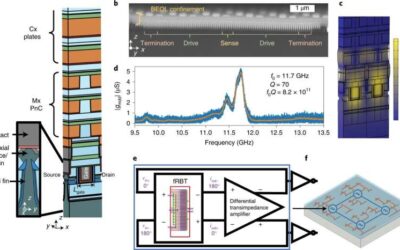A key objective of electronics engineering studies focusing on radio communication is the development of increasingly smaller, lighter, and low-power radio components. This could be achieved by integrating all radio components into a single chip, for instance by...
Electronics & Semiconductors
Gate-tunable heterojunction tunnel triodes based on 2D metal selenide and 3D silicon
Electronics engineers worldwide are trying to improve the performance of devices, while also lowering their power consumption. Tunnel field-effect transistors (TFETs), an experimental class of transistors with a unique switching mechanism, could be a particularly...
An optical fiber sensor-based mouthguard to operate devices by bite force
Conventional interfaces for computers and other electronics only allow humans to operate devices using their fingers. Recent technological advancements, however, have opened valuable opportunities for the development of alternative interfaces that use voice, eye...
An efficient and highly performing memristor-based reservoir computing system
Reservoir computing (RC) is an approach for building computer systems inspired by current knowledge of the human brain. Neuromorphic computing architectures based on this approach are comprised of dynamic physical nodes, which combined can process spatiotemporal...
The successful integration of a sub-0.5nm dielectric with 2D semiconductors
Field-effect transistors (FETs) are transistors in which the resistance of most of the electrical current can be controlled by a transverse electric field. Over the past decade or so, these devices have proved to be very valuable solutions for controlling the flow of...
A magneto-optic modulator could facilitate the development of next-generation superconductor-based computers
In the future, many computers will most likely be based on electronic circuits made of superconductors. These are materials through which an electrical current can flow without energy losses, could be very promising for the development of high-performance...
A new method to control the spin current and moment rotation in antiferromagnetic insulators
Antiferromagnetic materials, materials in which atoms are arranged so that all neighboring atoms are anti-parallel (i.e., pointing in the opposite direction) to them, can have several advantageous properties for the development of devices. Due to their fast spin...
A robot that draws circuits with conductive ink to survive
Recent technological advancements have paved the way for the creation of increasingly sophisticated robotic systems designed to autonomously complete missions in different familiar and unfamiliar environments. Robots meant to operate in uncertain or remote...
A new laser-based chlorination process to create high doping patterns in graphene
In recent years, electronics and chemical engineers have devised different chemical doping techniques to control the sign and concentration of charge carriers in different material samples. Chemical doping methods essentially entail introducing impurities into...
A computing in-memory system based on stacked 3D resistive memories
Machine learning architectures based on convolutional neural networks (CNNs) have proved to be highly valuable for a wide range of applications, ranging from computer vision to the analysis of images and the processing or generation of human language. To tackle more...










